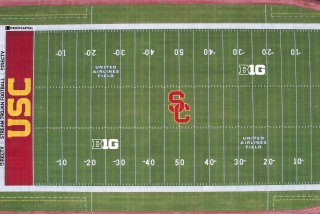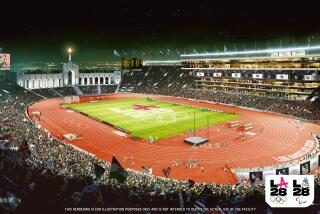75
The Coliseum is one man’s palace and another man’s pit.
One person sees the aged walls as full of history. Another thinks the walls should be history--or at least have luxury suites installed within them.
USC simply sees its glorious old home--for three-quarters of a century and 485 games, 346 of them victories.
When the Trojans play Purdue on Sunday in the Pigskin Classic, it will mark the beginning of their 75th-anniversary season in a stadium that first hosted a USC game on Oct. 6, 1923, only months after the Coliseum was completed at an original cost of $800,000.
After 75 years, with NFL owners still skeptical of plans for a new Coliseum and with the echoes of the 1932 and ’84 Olympics, the Rams, the Raiders, the Dodgers and UCLA football all fading away, USC plays on.
“I hope USC plays in the Coliseum forever and ever,” said Marv Goux, an assistant coach at USC from 1957 to ’82 who first stepped onto the Coliseum field as a high school player in 1948--when the stadium itself was a kid of 25.
Jesse Owens ran there, Sonja Henie skated, Jack Dempsey fought, Sandy Koufax pitched, O.J. Simpson rambled his way to the Heisman Trophy and Mary Decker fell.
For those who grew up in Southern California in a certain era, the Coliseum was the tip-top.
“It was the mecca of athletics. It was a symbol of Los Angeles and the entire athletic scene,” said Mike Garrett, the 1965 Heisman Trophy winner for USC who is now the school’s athletic director and says USC is “absolutely” content with the Coliseum just as it is after some $114 million in renovations in recent years, much of it in 1994 earthquake repairs.
“When I was growing up, one reason I played football in high school was because one time before I died, I wanted to play football in the Coliseum,” Garrett said. “If I could play in the Coliseum, I felt my life was complete.”
Garrett was the first of four USC Heisman winners who helped cement the Coliseum’s fame, followed by Simpson, Charles White and Marcus Allen, who played for the Raiders in the Coliseum too.
Although that sense of the Coliseum as the center of the athletic world has diminished, USC cornerback Daylon McCutcheon still remembers the drama of attending his first Trojan game as a junior in high school--and how different it was from the Raider games he went to as a younger boy.
“It was the Notre Dame game, and the Coliseum was really packed. There were no seats open,” McCutcheon said. “It was an awesome environment.”
Years earlier, his mother had stopped taking him to Raider games, an indication of the divergent atmospheres at the Coliseum.
“When I got older, they were so rowdy, she was scared to take me,” McCutcheon said.
Many people at USC still blame the Raiders for sullying the reputation of the Coliseum, and now, some of the greatest names in Trojan history are involved with other stadium proposals--a move based more on practicality than emotion.
John K. McKay, the son of former coach John McKay and a hero of the 1975 Rose Bowl, is an attorney who has been involved with the Hollywood Park proposal after becoming convinced the NFL won’t return to the Coliseum, though he still supports USC at the Coliseum.
And Anthony Davis, who scored six touchdowns in a 1972 victory over Notre Dame at the Coliseum and four in the famous 1974 comeback to beat the Irish, 55-24, is involved with a group seeking to bring the NFL to Orange County.
“The Coliseum, it means obviously a lot of great memories to me,” Davis said. “I’m part of the history.
“To me, I look at the Coliseum now as a historical spot. I don’t think it should even be touched in terms of reconstruction. That’s my opinion. It’s not because of what I’m doing for an NFL franchise in Irvine, it’s that to do that would be altering history, especially if you start talking about the outer shell. That’s my thought, that it should be left alone. Maybe paint it, but leave it alone.
“I know suites are state of the art, but I just think, historically, you preserve what’s there. It’s a landmark.”
The Coliseum knows how to make friends--and lifelong enemies.
Ara Parseghian, the Notre Dame coach from 1964 to ‘74, was 1-4-1 at the Coliseum.
Nobody talks about the 51-0 Irish victory in 1966.
It’s the undefeated teams that lost there in 1964 and 1970 and the USC victories led by Davis in ’72 and ’74 that are remembered.
‘It was not my favorite place, for obvious reasons,” Parseghian said. “We went out there undefeated two or three times and lost. Every time I walk into that stadium, the recollections are very vivid. I had the same sentiments when I visited it working for CBS and ABC. The place always brought back bad memories.
“I always thought about the big track, and the Trojan horse going around every time the Trojans scored.”
Even when Parseghian was invited to the Newport Beach home of John Wayne, he couldn’t escape the Coliseum. The Duke showed the coach around the house, lovingly displaying his gun collection, and then stopped dead in front of a framed photo of the Coliseum scoreboard: 55-24.
“Thanks, I appreciate that,” Parseghian told him.
Washington State Coach Mike Price never was much for the Coliseum either--until last season, when Washington State beat USC in the Coliseum for the first time since 1957.
“I used to hate going down there. The main reason was that we always had to play USC,” Price said. “It’s not that difficult a place to play--if the USC band isn’t in the tunnel. It’s not real loud, and the crowd is not real close to you. But we just couldn’t win there.”
When Washington State reached the Rose Bowl, the Cougars returned to the Coliseum, practicing there on fine December mornings, with the L.A. skyline crisp and clear behind them.
“Now that we’ve won and had our Rose Bowl practices there, I love that place,” said Price, who also embraced the neighborhood, turning the whole thing into a recruiting effort. “It was great for us to practice in the Coliseum, right there in the South-Central area, which we love,” he said. “‘We get a lot of good football players from there.”
The USC players who have called the Coliseum their home for a few years of their lives all have their favorite spots. For most, it is the tunnel that leads from the locker rooms to the field. Goux talks about the sound of the cleats as the players walk down the tunnel, past the opponents’ locker room as they prepare to step on the field.
“In that tunnel, when you’re walking down it, you can’t see the crowd,” McCutcheon said. “You start to hear it as you come out, and then you step out and can see the other end of the stadium, but not really the crowd. And then when you get on the field, you look around and see the whole crowd for the first time.”
Garrett likes the stadium best when it is full, the way he remembers the 1964 victory over Notre Dame, when Rod Sherman caught a touchdown pass from Craig Fertig with a minute-and-a-half to play, knocking the No. 1 Irish out of a national championship.
“It was deafening. You couldn’t hear the person next to you. We had to read lips,” Garrett said.
There have been so many memorable games, it’s impossible to count them. The dramatic 0-0 tie between USC and UCLA in 1939 sent USC to the Rose Bowl, Simpson’s 64-yard run against UCLA in 1967, Frank Jordan’s field-goal heroics in the late ‘70s, the 1981 last-second victory by No. 1 USC over No. 2 Oklahoma--and many, many a Notre Dame game.
For Goux, the year was 1974, the year of the 55-24 comeback.
“‘We came back from 24-6 at the half and all the people stood up the whole second half,” Goux said. “That’s the Coliseum. She’s a magnificent lady.”
The Coliseum was full once last season, with the usual 90,000-plus for UCLA. The crowds are always there for the Bruins and the Irish. For Nevada Las Vegas, though, there were 48,404. For Washington State, still early in its Rose Bowl run, only 51,655.
“I think the Coliseum is wonderful,” Garrett said. “The only thing we don’t have is sky boxes, and I don’t know if they would be [a large financial advantage to USC].
“I think it’s hard to fill because we haven’t played very well. If we win, people will show up.”
Other stadiums have been transformed. At Notre Dame, a $50-million expansion was completed before last season.
Yes, Garrett said, but there’s always the neighborhood.
“It’s still in South Bend.”
(BEGIN TEXT OF INFOBOX / INFOGRAPHIC)
USC Record on Home Fields
The USC football team’s record on home fields in California cities (Records include games played by USC at site when Trojans were not designated home team; USC totals include all games played on campus, including games played at Bovard Field; Rose Bowl totals include games played against UCLA):
*--*
Site W L T Pct. Coliseum 346 112 27 .741 USC 58 10 5 .829 Rose Bowl 24 15 0 .615 Fiesta Park 12 8 2 .591 Prager Park 4 2 0 .667 Athletic Park 0 3 1 .125 Tournament Park 4 0 0 1.000 Washington Park 0 3 0 .000 Chutes Park 0 1 1 .250
*--*
More to Read
Go beyond the scoreboard
Get the latest on L.A.'s teams in the daily Sports Report newsletter.
You may occasionally receive promotional content from the Los Angeles Times.






